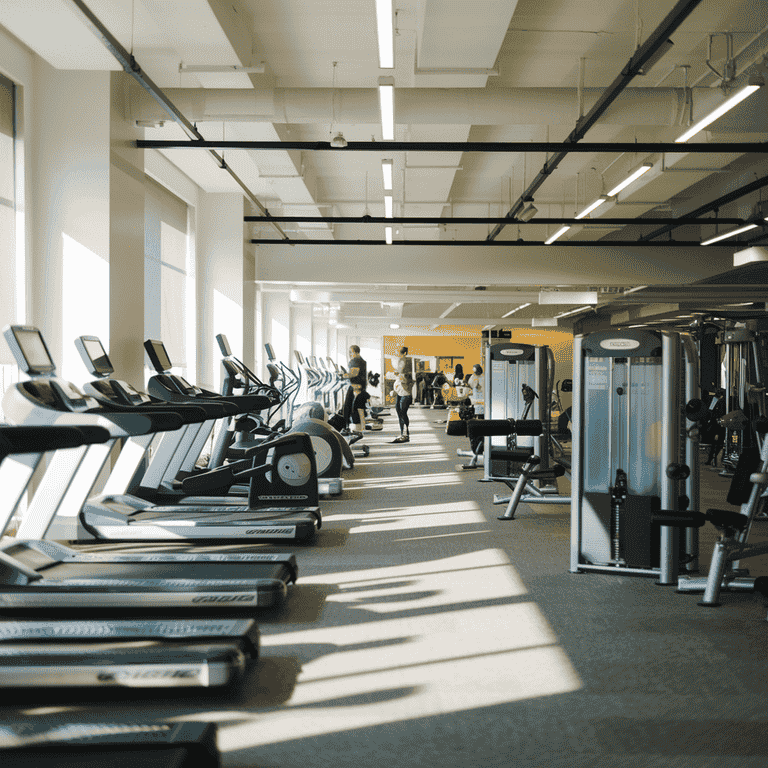If you run a gym and want more people to walk through your doors, gym SEO should be on your radar. Gym SEO ensures your business appears when someone in your area searches for a place to work out.
Most people look online before they choose a gym. If you’re not on page one, you’re invisible. The good news? With the right SEO strategy, your gym can reach the top of local search results and bring in more paying members.
In this article, we’ll explain gym SEO, how it works, and what you can do to start improving your rankings immediately.
Gym SEO (search engine optimization) improves your gym’s visibility in search engines like Google. The goal is simple: when someone in your area types in “gym near me” or “personal training in [your city],” your gym shows up at the top.
Here’s what gym SEO includes:
When done right, SEO helps you appear in:
And that visibility leads to more:
SEO isn’t just for big national brands. It works incredibly well for local gyms that want to grow.
Before appearing in search results, you must know what people are typing into Google. That’s where keyword research comes in.
You want to focus on keywords indicating someone is ready to join a gym or try a class. These are called high-intent keywords.
Here are some examples of local, high-intent keywords:
KeywordIntent
“gym near me” Ready to find a local gym
“personal trainer in Miami” Looking for personal training
“24-hour gym in Dallas” Searching for a specific feature
“kickboxing classes NYC” Interested in a particular class
Notice how all these include a city, neighborhood, or service? That’s what you want.
Use free tools like:
Don’t just focus on general “gym” terms. Think about everything you offer.
Include keywords for:
Use a mix of broad and narrow terms, like:
There are two main types of keywords:
TypeExampleProsCons
Short-tail “gym,” “personal trainer” High search volume High competition
Long-tail “affordable gym in Houston open late” Easier to rank for Lower search volume
For most gyms, long-tail keywords are where you’ll get the most traction—especially in local searches.
Use them across your website, blog, and Google Business Profile.

Once you know what keywords people are searching for, it’s time to place them on your website. This is where on-page SEO comes in. It’s all about how your content is structured and optimized so Google (and your visitors) can understand what your gym offers.
Your homepage is often the first impression. Make it count—not just for visitors but also for search engines.
These are what show up in Google search results. They’re short but powerful.
Example:
Tips:
Use headers (H1, H2, H3) to break up content and include keywords naturally.
Also, link to other important pages on your site:
This helps both users and search engines navigate your site better.
You should have separate pages for each core service your gym offers.
Here are a few examples:
Each service page should follow this structure:
Example headline:
“Personal Training in Houston for All Fitness Levels”
Use keywords naturally throughout:
But avoid keyword stuffing. Write like a real person. Google notices.
Blogging helps you appear for more searches and build trust with your audience. Plus, it gives you fresh content—something Google likes.
Here are blog post ideas that rank well and attract readers:
Use your keyword research to pick topics people are already searching for.
Pro Tip: Use free tools like Hemingway or Grammarly to keep your writing clear and easily read.
Local SEO is one of the most essential pieces of gym SEO. People looking for a gym usually want one close to home or work. If your gym doesn’t appear on Google Maps or in the “local 3-pack,” your competition gets the call instead.
Here’s how to fix that.
Your Google Business Profile (GBP) is often the first thing people see before visiting your website.
Your business name, address, and phone number should be 100% consistent everywhere it appears online.
That means:
Minor differences—like “Street” vs. “St.”—can confuse Google.
Pick the most relevant primary category, like:
Then, add secondary categories if needed (e.g., Yoga Studio, Bootcamp).
Fill out every field possible:
Use real photos of your gym—inside and outside, classes in action, trainers working with clients—and avoid stock photos.
A citation is any mention of your business online. You want as many high-quality citations as possible—especially from local and industry-specific directories.
Here are the top places to start:
DirectoryWhy It Matters
Google Business Profile The most important one—do this first
Yelp’s High authority and often ranks well
Facebook Helps with visibility and trust
Apple Maps Big for iPhone users
Bing Place still gets traffic
MapQuest Used by some local search apps
YellowPages Trusted citation site
Local Chamber of Commerce Builds local trust and authority
There are also fitness-specific directories like:
Use a spreadsheet or tool like BrightLocal or Whitespark to keep track of all listings.
Make sure your NAP is:
Reviews build trust and help your gym rank higher in local search.
Ask happy members for reviews! It’s that simple.
Tips:
Just don’t buy reviews or fake them. Google is cracking down hard.
Always respond—good or bad.
Positive review response:
“Thanks so much for the kind words, Sarah! We love having you at the gym. See you at spin class!”
Negative review response:
“Sorry to hear about your experience, James. We’d love the chance to make it right—please get in touch with our manager at [email].”
Responding shows you’re active, attentive, and care about your members.

Technical SEO ensures your gym website is built to perform well both for users and search engines. If your website isn’t running smoothly, it won’t rank well. Google wants to provide the best possible user experience, so your site needs to be fast, secure, and easy to navigate.
Here’s how to make sure your gym website meets technical SEO standards.
Most people search for gyms on their phones, so if your site isn’t mobile-friendly, you’re losing out on potential members.
Make sure your site looks great and works well on all screen sizes. Use a responsive design that adjusts automatically to different devices.
Speed is crucial for user experience and SEO.
Tools like Google PageSpeed Insights can give you specific suggestions to speed up your site.
Google gives a ranking boost to secure sites. That means you need an SSL certificate.
You can easily check if your site is secure by looking for a padlock symbol beside your URL. If your website isn’t using HTTPS, it’s time to get that SSL certificate.
Crawl errors happen when search engines try to visit your site but can’t reach certain pages. Broken links can make your website feel unprofessional and frustrating to use.
Link building is an essential part of SEO that helps your gym gain authority in Google’s eyes. The more high-quality links that point to your website, the more Google sees you as a trustworthy and relevant source of information.
Here’s how to build links to your gym’s website and boost your SEO.
Collaborating with other local businesses is a great way to get high-quality links and build your presence in the community.
Here are some ideas:
Get listed in industry-specific directories. Here are some places to start:
DirectoryDescription
Fitness.com: A popular site for gym listings and information
Health & Fitness Industry Council: A well-known directory for fitness professionals
Local Health Websites Many cities have fitness-focused listings and directories
Getting covered by local media outlets, like news stations or newspapers, is a great way to get links to your site. If you do something newsworthy—like opening a new location or hosting a community event—pitch the story to local reporters.
Guest blogging is when you write a blog post for another website in exchange for a link to your gym’s site. It’s a powerful way to get high-quality links and reach a broader audience.
Creating valuable content can attract links naturally. Think about offering:
When your content is valuable and shareable, other websites will link to it, which will benefit your SEO.

Tracking SEO performance is key to understanding if your efforts are paying off. Without proper monitoring, you might be spinning your wheels without knowing what’s working and what isn’t.
Tracking your SEO performance allows you to:
Here are the main SEO metrics you should keep an eye on:
The amount of traffic coming from Google and other search engines. This clearly shows how well your site ranks for relevant keywords.
Tracking the positions of your target keywords is vital. If you’re ranking for terms like “best gym in [city]” or “personal training near me,” you’re on the right track.
It’s great to have traffic, but conversions are the real goal. Whether people sign up for a class, fill out a contact form, or call your gym, conversions really matter.
To track your SEO performance, you’ll need the right tools. Here are a few essentials:
ToolPurpose
Google Analytics Track overall traffic and conversions
Google Search Console Track rankings, impressions, and clicks
SEMrush Analyze keyword rankings and backlinks
Ahrefs Deep dive into backlinks and SEO performance
Moz Monitor site health and keyword rankings
These tools provide actionable data and help you clearly see how your gym website is performing.
Some common mistakes can hurt your gym’s SEO efforts even with the best strategy. Avoiding these pitfalls will ensure you’re on the right path.
Keyword stuffing occurs when you unnaturally overload your content with keywords. While this may seem like a quick fix to improve rankings, it can backfire.
Ignoring local SEO can cost you valuable traffic, mainly if your gym relies on local customers. You’re missing out if you do not appear in local search results.
More people are using smartphones to search for gyms. If your website isn’t mobile-friendly, you’re losing potential customers.
If visitors land on your website but don’t know what to do next, your SEO efforts will not pay off. Without clear CTAs, you will not convert those visitors into members.
Outdated content can hurt your rankings. Google prefers fresh, relevant content.
SEO is constantly changing. To stay ahead of your competition, keeping up-to-date with the latest trends is essential.
More people are using voice search to find information online, especially on their smartphones or smart speakers. Gym owners should be aware of how voice search affects their SEO strategy.
Video content is becoming increasingly important for SEO. Google loves video, and it can help keep people engaged on your site longer.
AI is making waves in SEO. While AI tools can’t replace a solid SEO strategy, they can help you make smarter, faster decisions.
Reviews are becoming increasingly important for local SEO. Positive reviews help your gym rank better and build trust with potential members.
Gym SEO is crucial for standing out in a competitive market. You can improve your visibility and attract more clients by focusing on local SEO, optimizing your website, and using effective strategies like link building and content marketing.
Remember, SEO isn’t a one-time task. It’s an ongoing effort that requires consistent attention. Track your performance, adjust strategies as needed, and stay on top of industry trends.
By implementing these proven techniques, your gym will not only appear higher in search results but also convert visitors into long-term members. So, take action now and start building your gym’s online presence today.
Stay ahead of your competitors by prioritizing SEO, and watch your business grow!
Most gyms begin to see noticeable improvements within 3 to 6 months, especially in local search rankings. However, SEO is a long-term strategy. The more consistent and strategic your efforts, the better the results over time.
Yes. A blog allows you to regularly add fresh content, target long-tail keywords, and address common questions your audience is asking. It also gives Google more reasons to index your site and helps position your gym as a helpful, trusted resource.
Paid ads (like Google Ads) bring quick visibility but stop the moment you stop paying. SEO takes longer but builds a foundation of organic traffic that doesn’t rely on constant ad spend. Ideally, both can work together in a broader marketing strategy.
Indirectly, yes. While social media signals aren’t a direct ranking factor, strong engagement can drive traffic to your site, increase brand awareness, and lead to backlinks—all of which support your SEO goals.
At minimum, review and refresh your key pages (like your homepage and services) every 6 to 12 months. Blog content can be updated or added monthly to keep your site active and relevant.
Google Business Profile – Set up or manage your Google listing to improve your local SEO visibility and appear in the local map pack.
Google Search Console – Monitor your gym website’s performance in search results, fix errors, and understand what keywords bring in traffic.
Google Analytics – Track website visitors, traffic sources, conversions, and more to measure the effectiveness of your SEO.
Moz – Offers tools and educational resources for improving your gym’s keyword rankings, tracking backlinks, and managing local SEO.
Ahrefs – A powerful SEO toolset that helps analyze backlinks, competitor strategies, and keyword opportunities for your gym.
BrightLocal – Specialized in local SEO tools, this platform helps you manage local listings, track local rankings, and gather customer reviews.
Yoast – A trusted SEO plugin for WordPress users that helps you optimize your website content for search engines in an easy, beginner-friendly way.

Before you go—just a quick reminder:
Our co-founder, Matt LaClear, provided the SEO tips shared on this page. Since 2009, he’s worked on over 13,277 SEO campaigns for clients nationwide. He’s seen what works (and what doesn’t) for small businesses—especially in competitive spaces like gyms.
You’re invited to take advantage of a special offer:
Matt is offering a free custom SEO strategy call to help you understand exactly what your gym needs to start ranking higher and faster.
Don’t miss the chance to get honest advice from someone who’s been doing this successfully for over a decade. Reach out today and claim your free call.
Copyright Digital Wins 2024